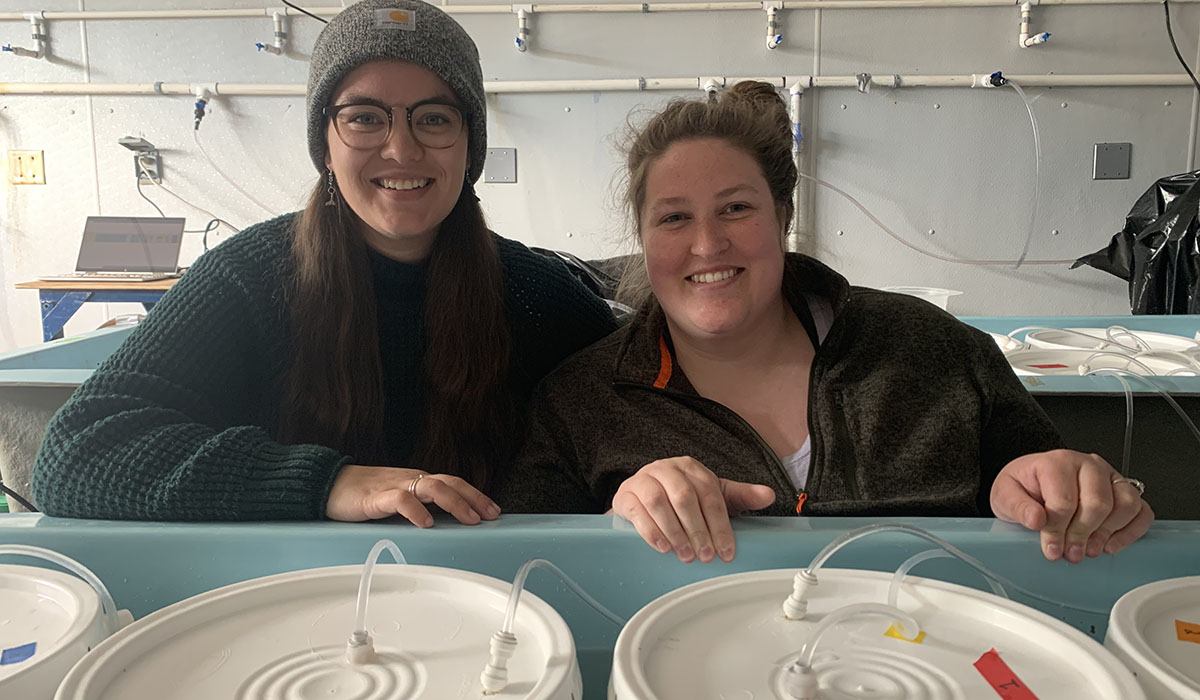Salmon Tipping Points: Lab Study
Response of Alaska juvenile pink salmon to ocean acidification conditions in the lab back to Salmon Tipping PointsThe increase in carbon dioxide in the atmosphere from human activities is driving a long-term increase in ocean acidity, a process known as ocean acidification (OA). Lab research has shown that OA can have direct, negative impacts on marine organisms by affecting growth, calcification, reproduction and survival. Ocean acidification can also affect marine foodwebs as many prey species are sensitive to changes in ocean chemistry. Alaska is naturally predisposed to ocean acidification because of its cold water and other factors, and understanding how species of economic and alimentary importance may respond is vital to help inform future fisheries management and adaptation.

The Research Question
This study was a multi-stressor experiment looking at the direct effect of exposure to future ocean acidity conditions and the indirect effect of reduced food availability on juvenile pink salmon.
What We Did
Juvenile pink salmon were exposed to treatments with increased pCO2 (which increases the acidity) and reduced food availability for six weeks at the Alutiiq Pride Marine Institute in Seward, AK. Researchers from UAF measured developmental, physiological,and otolith mineral characteristics over the course of a 6 week period. The pCO2 conditions were consistent with conditions we would expect to see in the year 2100 under the Intergovernmental Panel on Climate Change’s Representative Concentration Pathway 8.5 emissions scenario, or “behavior as usual”.
Treatment: ambient pCO2 (400 µatm)/ambient food availability (3% body mass), elevated pCO2 (1,100 µatm)/ambient food availability, ambient pCO2/reduced food availability (1.5% body mass) or ambient pCO2/reduced food availability.
The more CO2 generated or injected into seawater, the lower its pH level will be. This is caused by the interaction between CO2 and H2O, which results in a release of carbonic acid. Lower pH corresponds to higher acidity.
What We Found
- Weight and the weight-to-length ratio (conditional index) were significantly smaller in fish exposed to future OA conditions
- Stress hormone levels (cortisol) were significantly higher in fish exposed to future OA conditions and reduced food availability. Additionally, cortisol levels increased significantly during the 1-3 week period.]
- The mass-specific routine metabolic rate was significantly higher in fish exposed to future OA conditions and reduced food availability, and increased significantly over the course of the 6-week experimental period.
- Vaterite presence was significantly higher in the fish that died unexpectedly during the experiment compared to fish collected during regular sampling intervals. Vaterite is a mineral that can grow in the inner ear (otolith) of fish and may impair hearing and balance and affect fitness-related behaviors such as avoiding predators.
Why It Matters
- Sublethal impacts to salmon from OA can affect fisheries. While there was no significant effect of direct exposure to future OA conditions on juvenile pink salmon survival, the sublethal (not deadly) effects related to growth, stress and metabolic rate were significant and could create population-level implications. These potential physiological changes should be incorporated into climate change mitigation and adaptation planning.
- Subsistence, commercial and recreational resource users may be impacted by OA. Juvenile pink salmon had a significant reduction in weight under future OA conditions which could potentially influence the total number of fish needed to meet the needs of harvesters. The increased metabolism of salmon in these conditions may also displace other target species through direct competition for prey.
- Measurable effects require time. Previous studies on juvenile pink salmon did not detect any impacts of OA on growth or physiology. However, the previous studies were short (~2 weeks). Our work demonstrated that the impacts of OA began to appear after two weeks of exposure, highlighting the need for laboratory studies to be carried out for longer periods of time.
What Future Work Would Be Helpful?
- Exploring the interactive effects of OA and ocean warming would be a logical next step to determine the potential resilience or susceptibility of pink salmon to ocean change.
- Developing experiments to better understand the unexplained mortality that was documented in this study
- Better understanding the impact of increased vaterite presence
Principle Investigators
Amanda Kelley, Marina Alcantar, Shelby Bacus. University of Alaska Fairbanks.
Our Partners

